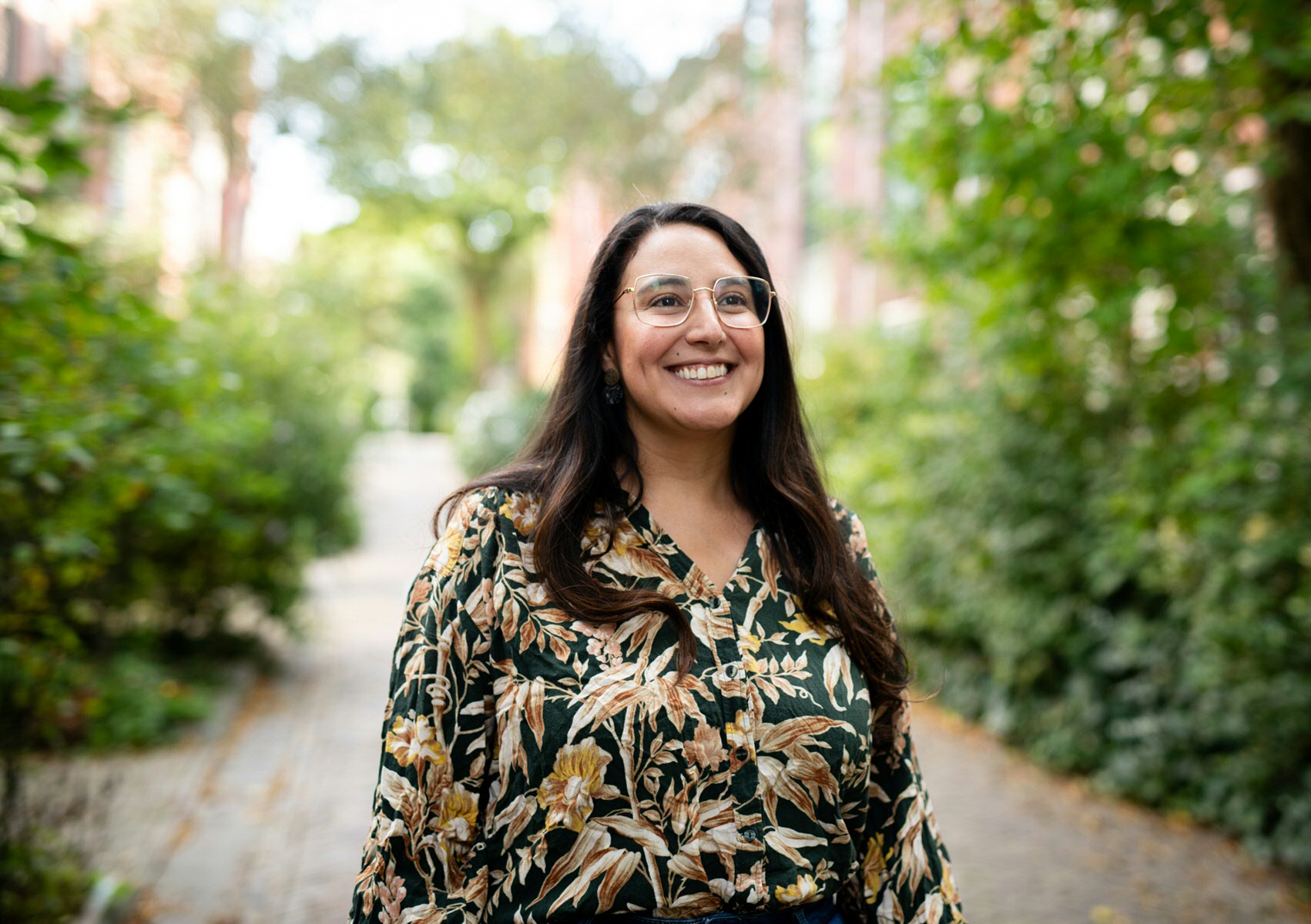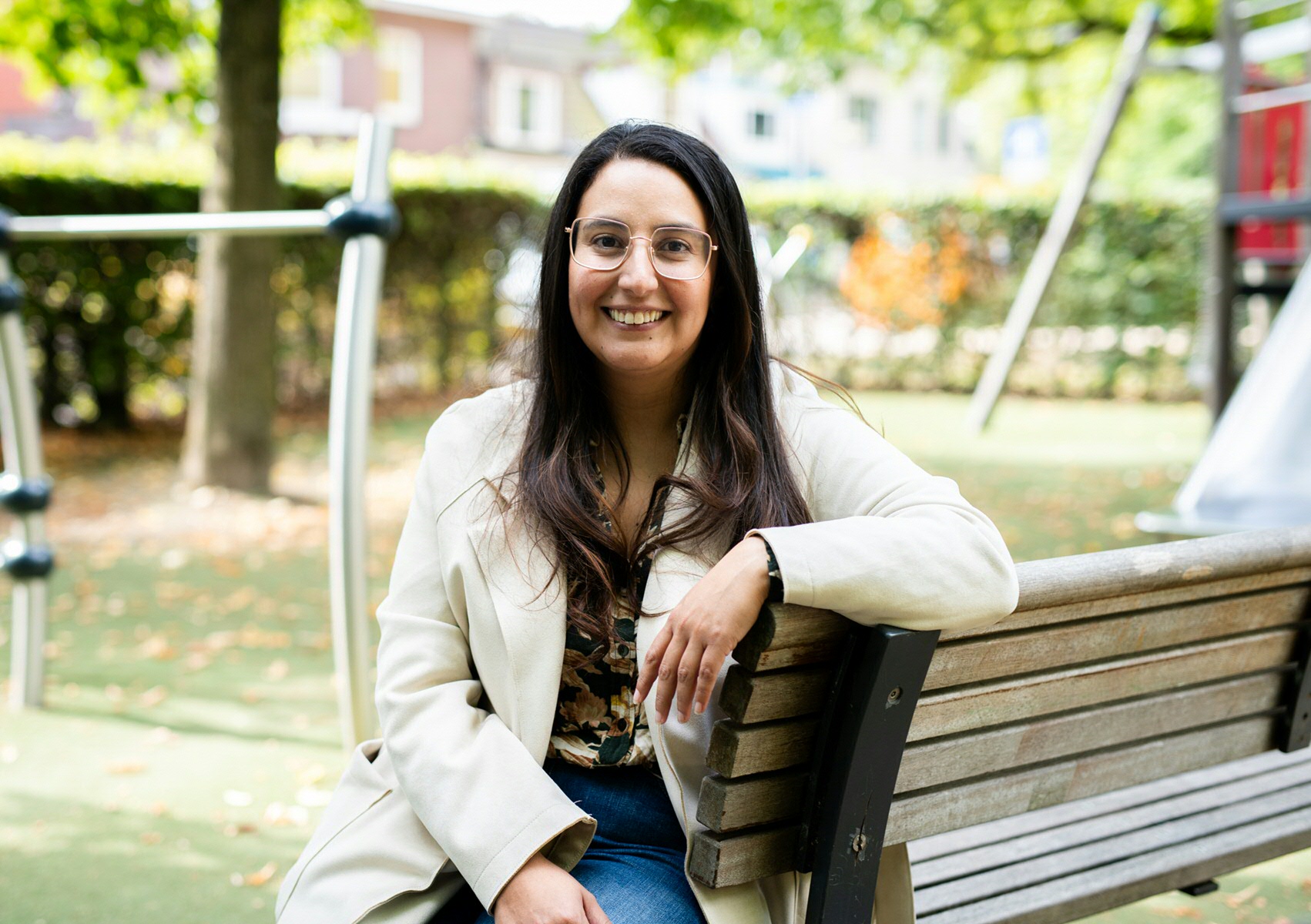Only together can we create child-friendly cities
A city that is pleasant to grow up in. Safe, playful, with organic encounters between residents from different generations and social classes. That is Viviana Cordero Vinueza’s mission. In Groningen, the Ecuadorian PhD student brings together centuries-old values from Indigenous Ecuadoran cultures with lived experiences and global academic insights. Children are her guide.
Text: Riepko Buikema, photographs: David Vroom
At a picnic table on the Zernike Campus, Cordero Vinueza recalls a trip she took somewhat by chance when she was just starting out as a lawyer. ‘I wanted to contribute to a more just society, but working at a law firm didn’t suit me. Architects that I’m friends with asked me to join them for a workshop on urban planning in Nicaragua. That is when we were hit by an earthquake.’

Justice
It was amidst the horrors of the natural disaster that Cordero Vinueza found her inspiration. ‘It started out very small, very conceptual. In the destroyed city, we hung simple wooden cubes in the trees to mark places where people could find relief from the heat. And look at what happened! People showed up, created a sort of small market, and held meetings to discuss the reconstruction. One woman in particular was so grateful. She said: “This is incredible; now we have a place to meet each other and find resilience.” That was my wow moment. I realised that this is justice. This is what I want to do. If you design cities in a sensible way, you can create opportunities for people from day one.’
Inca Empire
Back in Cuenca, Ecuador, where she was living at the time, that spark led to the foundation of Huasipichanga, a collective of people who are working to improve public spaces: to make them safer, more inclusive, and more comfortable. Key principle: this is only possible when we work together, when we co-create with communities, governments, and business owners. ‘Huasipichanga means housewarming party in Quechua, the most important language of the Inca Empire. Our Indigenous peoples believe that you don’t build a house for yourself or your family, but with and for your community. Moving into a new house is traditionally largely celebrated.’
Grandma’s furniture
After the earthquake in Nicaragua, the socially-driven urban innovators are also experiencing the power of starting small in their own country. ‘In Cuenca, there’s a beautiful stairway connecting the historical part of the city to the new city centre. It used to be very dark there though, not a nice place to be in the evening.’ Cordero Vinueza and her associates came up with an unorthodox intervention. She laughs heartily: ‘We loaded furniture belonging to one of our grandmothers into a car and, on one of the landings of that staircase, rebuilt her exact living room. We sat down and read magazines, chatted, and laughed, just like that.’
The homely cosiness is contagious; curious people and passers-by stick like bees to honey. ‘One person brought a guitar, another recited poems. A museum offered us coffee, electricity, and loudspeakers. That’s how our weekly living room continued to grow each Thursday. The municipality was astonished and about to ban music in public spaces. Thankfully, we had the chance to ask visitors and allies about their experiences. As a result, the proposed bill was withdrawn, street artists would now receive funding for their performances, and so we changed municipal policy together.’
Children are the experts
Gradually, Cordero Vinueza shifts her attention to the youth, partially due to the both bizarre and painful observation that here, with Ecuador’s pleasant weather, children can’t walk anywhere. ‘We’re Latinos, we’re always outside. But even in Cuenca, our safest city, children are always brought to and picked up from school by car, or they take a school bus. This leads to traffic jams; traffic is madness.’
Cordero Vinueza lights up when she talks about small successes, about how she learned to trust the knowledge and judgement of the youngest generation, and how they have found a place in the process of urban innovation. ‘Children are the experts of every place, the incredibly honest messengers of what their community needs the most.’ This led, for example, to a neighbourhood where children painted the covers of their favourite music albums onto manhole covers, creating an organic route to the nearby park they never went to before. ‘That behavioural change in children is the best part of my job.’

Rotterdam and Groningen
In this way, Cordero Vinueza saw the most beautiful examples in practice that really show exactly how to make a street more friendly. In addition, there is plenty of scientific evidence that child-friendly cities contribute to physical development, health, resilience, and safety. So why do we rarely implement this? What is stopping municipalities from doing so? Those are the questions that brought the Ecuadorian to the Netherlands, to pursue a Master’s degree in Urban Planning in Rotterdam and PhD research in Groningen.
Close to the heart
‘In academia, municipal processes or the implementation of child-friendly policy are hardly ever discussed. That’s the gap I’m focusing on: how do we get municipalities to the point where they actually start doing this? After conducting a large literature review, I’m now researching the agenda setting in thirty cities worldwide. It has become clear that national governments determine much of municipal policy, for example in terms of budgeting and technical assistance. Beyond that, I’ve noticed that once municipalities are aware of a need, they actually work to try and improve it. Of course, it’s also a topic that representatives often understand on a personal level, as a child-friendly city is close to anyone’s heart.’
Perfect
Europe is the perfect place for the academic continuation of her real-life experiences in Ecuador, says the researcher. Here she has access to knowledge, funding, and a professional network. With these, she has been able to develop Huasipichanga into an enterprise with international clients and projects. In addition to doing her PhD research, the co-founder works for the company one day a week.
‘In the future I’d like to spend six months a year in Europe, teaching about the South American sense of community, among others. We South Americans are used to a shortage of resources, so we use them more sparingly. We work better collaboratively, and faster too. In the second half of the year, I’d then be able to implement the knowledge from Europe in Ecuador. Again she laughs: ‘It’d work both ways, and I could happily skip the Dutch winters.’
In comparison to the rest of the world, the Netherlands is one of the best places to grow up in, Cordero Vinueza believes. ‘Friends from Ecuador ask me for jobs in the Netherlands, so they can raise their kids here. But my biggest dream is that all children can grow up the Dutch way in Ecuador. And not just the fortunate ones.’
More information
-
Contact: Viviana Cordero Vinueza
-
Viviana Cordero Vinueza’s profile on LinkedIn
-
Huasipichanga website
| Last modified: | 11 December 2023 2.41 p.m. |
More news
-
08 May 2024
Juliette de Wit, Femke Cnossen and Maite Laméris receive YAG grant
Juliette de Wit, Femke Cnossen and Maite Laméris have received a YAG Grant of € 6,000 for an interdisciplinary project on the long-lasting socio-economic consequences of the ‘Arbeitseinsatz’ in the Netherlands. The grant enables them to explore...
-
23 April 2024
From battling against the water to living with the water
Margo van den Brink, associate professor of Water and Planning, says that we should adapt our spatial design to the changing climate. This implies difficult choices have to be made because the space is limited and the needs are great.
-
16 April 2024
Investors consider region a risk
Investment in real estate appears to be an important explanation for the gap between big cities and the region, argues Michiel Daams, associate professor of Economic Geography of the Real Estate Market. He conducted research on investments in the...
